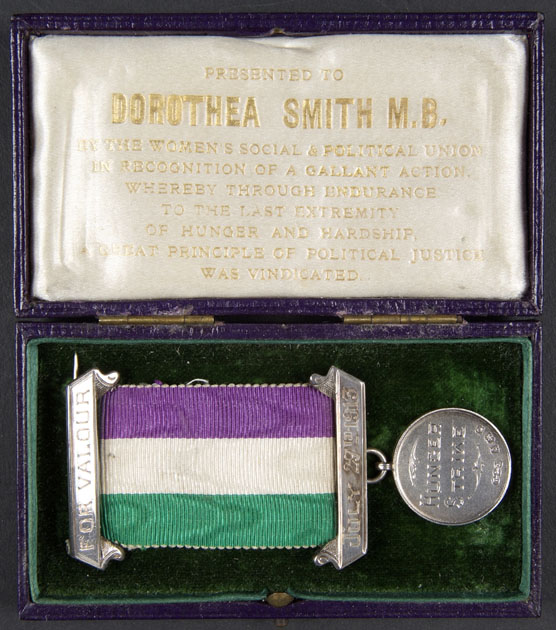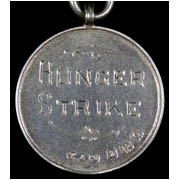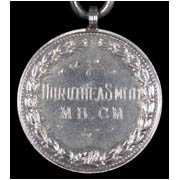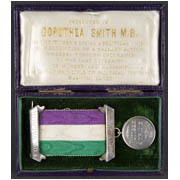Details
- Object type
Hunger Strike medal and case
- Artist/Maker
Toye & Co. maker
- Place Associated
England, London (place made); Scotland, Glasgow (place associated)
- Date
1913
- Materials
silver, silk, velvet, card
- Dimensions
medal: 76.2 mm x 40.64 mm (approximately); case: 101.6 mm x 55.88 mm
- Description
-
Hunger Strike medal in presentation case awarded to Dr Dorothea Chalmers Smith by the Women’s Social and Political Union (WSPU).
The silver medal is attached to a green, white and purple striped ribbon with two silver bars. The top bar is engraved ‘FOR VALOUR’ with the maker’s name and address stamped on the back and a fastening pin. The lower bar is engraved ‘JULY 29th 1913’ with ‘CAT AND MOUSE’ on the reverse. The medal is attached to the lower bar by a loop. The front of the medal is engraved ‘HUNGER STRIKE’ with a decorative scroll above and below and hallmark along lower rim. The reverse has a wreath around the rim with ‘DOROTHEA SMITH M.B.C.M.’ engraved in the centre.
The dark purple hinged presentation case opens to reveal a padded green velvet base on which the medal rests and a padded white silk lid interior printed in gold with ‘PRESENTED TO DOROTHEA SMITH M.B. BY THE WOMEN’S SOCIAL AND POLITICAL UNION IN RECOGNITION OF A GALLANT ACTION WHEREBY THROUGH ENDURANCE TO THE LAST EXTREMITY OF HUNGER AND HARDSHIP, A GREAT PRINCIPLE OF POLITICAL JUSTICE WAS VINDICATED’.
Dr Chalmers Smith, a medical doctor and early female medical graduate of the University of Glasgow, was arrested along with artist Ethel Moorhead as they attempted to set fire to an empty house in Park Gardens, in Glasgow’s west end. By 1913, WSPU activity had become more militant, including arson on empty property. The women were sentenced to eight months imprisonment and immediately went on hunger strike. Under the ‘Cat and Mouse Act’ referred to on the medal, they were released to recuperate. This act, the 1913 Prisoners (Temporary Discharge for Ill-Health) Act, allowed for the early release of prisoners weakened by hunger strike and for their recall to prison on their recovery. Dr Chalmers Smith evaded the police waiting for her outside her Dennistoun home in Glasgow’s east end by dressing up as a schoolgirl and walking past them.
WSPU member Helen Crawfurd later wrote that Dr Chalmers Smith and her sister later visited her. Dr Chalmers Smith was ‘dressed up like a schoolgirl with two long pig tails, large horn rimmed glasses, girl’s frock, long black stockings, and an innocent schoolgirl expression on her face. She had walked out under the noses of the police. It was so well done, that I really thought she was one of Dr Chalmers Smith’s schoolgirl daughters’.
The green, white and purple colours of the medal ribbon and box are the colours of the WSPU. They were adopted in 1908 and gave the organisation an immediate visible identity. As described in the WSPU newspaper, ‘Votes for Women’, purple stood for the instinct of freedom and dignity, white for purity in private and public life and green for hope.
Suffragette prisoners went on hunger strike to protest at not having political prisoner status while imprisoned for campaigning for full voting rights for women. The WSPU presented medals to suffragette prisoners who went on hunger strike.
- ID Number
PP.1984.132.3
- Location
In storage



